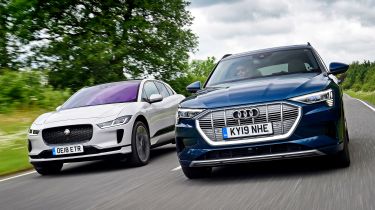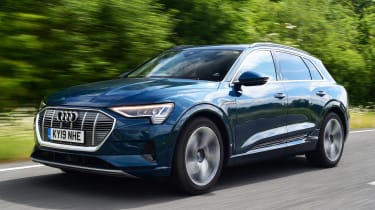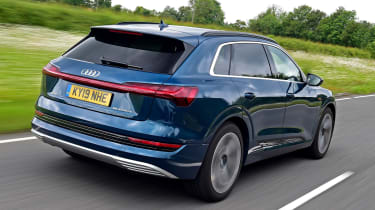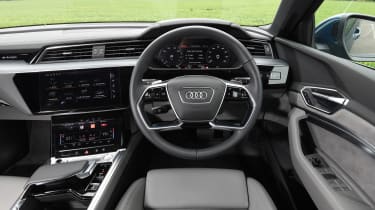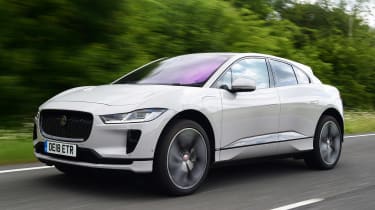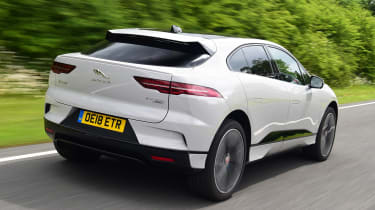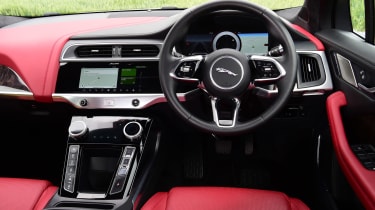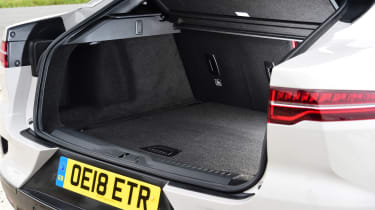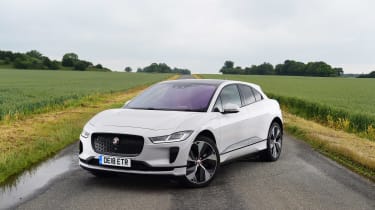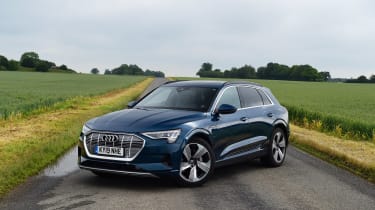Audi e-tron vs Jaguar I-Pace
We see if the new all-electric Audi e-tron can gain the upper hand on our reigning Car of the Year, the Jaguar I-Pace
You might have expected premium brands like Audi to have led the charge with electric-vehicle development, but the German firm has taken a surprisingly long time to launch an all-electric product.
Now Audi has turned the taps on, though, and it’s here with its first full EV: the e-tron. This SUV costs just over £70,000 even after the £3,500 Government grant has been deducted – but then, you do get a considerable amount of technology for that premium price tag.
Even though upmarket electric SUVs are still few and far between, that price point and the Audi’s 95kWh battery put it in a small but select group that our reigning Car of the Year, the Jaguar I-Pace, currently sits at the top of.
This is in every sense the benchmark the e-tron has to match up to. There are many elements to consider when it comes to living with an electric car – from range and usability to performance, tech and practicality – and given factors such as the engineering technology that underpins it and the space on offer, it’s going to be a close-run contest.
Audi e-tron
The e-tron is Audi’s first full EV. That badge has been used on plug-in cars before, but the tag now represents the brand’s electric models. At £72,270, this is the cheaper of the two variants available (there’s a higher-spec Launch Edition in the line-up, too), but it still gets plenty of kit. Let’s see how it fares.
Design & engineering
The e-tron is based on a heavily adapted version of the MLB architecture, with the 95kWh battery mounted in the floor. This is partly why the car sits up high and partly why it’s so heavy, at 2,490kg. Weight is the enemy of efficiency, so this seems slightly at odds with the e-tron’s ethos.
Used - available now

2021 Renault
Zoe
44,663 milesAutomaticElectric
Cash £9,163
2024 Volkswagen
Golf
8,875 milesManualPetrol1.5L
Cash £20,950
2022 Mercedes
CLA
18,905 milesAutomaticPetrol1.3L
Cash £23,463
2020 Land Rover
Discovery Sport
68,531 milesAutomaticDiesel2.0L
Cash £17,663The car uses two electric motors, one on each axle, for a total of 402bhp and a different take on Audi’s quattro four-wheel drive. Like pretty much every electric car, there’s a single-speed automatic gearbox.
Air suspension is also standard, unlike on the Jag. It’s linked to the car’s drive mode select set-up, offering Offroad, Allroad, Comfort, Auto, Efficiency and Dynamic.
This is integrated in the lower of the two touchscreens. It’s an 8.6-inch unit that mostly controls the climate settings. The upper 10.1-inch screen is used for the infotainment, while there’s a 12.3-inch Virtual Cockpit, too. It’s nice tech, but not very different from that found in more conventional Audis, with positives and negatives to this.
You get lots of kit even in this base spec, although that’s a relative term. This entry-level e-tron does without the car’s trademark virtual door mirrors, but it has nav, phone integration and lots of safety equipment. There are also 20-inch alloys, climate and adaptive cruise control, a 360-degree camera, heated leather seats, LED lights, DAB, wireless charging and keyless operation. It’s all integrated into a cabin that’s executed with the usual quality we’ve come to expect from an Audi. Materials and build quality are good.
Driving
EVs are characterised by their relaxing driving experience. An instant and fat swell of torque means many are smooth and serene, and sharp, responsive performance is another common trait. While the Audi is definitely relaxed, acceleration isn’t anywhere near as impressive as in the I-Pace.
It’s partly due to the weight. The Audi is very heavy, and this dulls the punch when you hit the throttle. It’s far from slow, but it could be more rapid.
It took 5.4 seconds to sprint from 0-60mph compared with 4.4 seconds for the Jag, but EVs are as much about easily exploitable acceleration at any speeds. At least the e-tron has enough urgency here; it took 1.7 seconds to go between 30 and 50mph, although this was still slower than the I-Pace.
It’s not as quick, then, and also not as comfortable. Despite the e-tron’s standard air suspension, on these £950 21-inch wheels the Audi’s alloys rebound aggressively over harsh bumps. It’s more settled on the motorway, where the car’s weight means the damping feels smoother at higher speeds. But then its near-2.5-tonne bulk means it’s not very agile.
The steering has even less life than in most other Audis and you sense the weight trying to tear the e-tron off your chosen line. Special mention should go to the torque-vectoring system, though; this shuffles power to help it turn better. You can feel it working unobtrusively to improve the car’s handling.
Practicality
Thanks to where the e-tron’s battery is located in the chassis, there’s a useful 660 litres of boot space. The Audi’s footprint is also larger than the Jaguar’s, which translates to more room in the cabin as well.
The practicalities of living with an EV are as much about charging, and with up to 150kW charging capacity available, e-tron charge times are respectable. Using a 3.6kW domestic feed a full charge will take 26 hours and 45 minutes. Very few EV owners will do without a home wallbox, though; an 11kW supply like this will top up the battery in a much more respectable eight hours and 45 minutes, so you’ll be able to go from empty to full overnight.
Rapid charging at 50kW – currently the most common option in the UK – takes 70 minutes for an 80 per cent boost, while charging at the e-tron’s maximum 150kW rate (there are only a handful of chargers that support this in this country at the moment) gives an 80 per cent top-up in 30 minutes.
Ownership
With fewer moving parts than a normal car you’d expect electric vehicle servicing to be more affordable. Not with the e-tron, though, because a two-year package costs £799. Jaguar is planning a new service plan range for this summer, but prices aren’t out yet.
Audi came 16th in our Driver Power 2019 satisfaction survey to Jaguar’s ninth, but the e-tron’s safety is strong and it gets a full five-star crash test rating, thanks to standard autonomous braking and lane-departure warning. Blind-spot warning and rear cross-traffic alert are part of a £625 pack.
Running costs
Electric cars are all about efficiency, but the Audi’s effort is a little disappointing. We saw 2.3 miles per kWh, which means its 95kWh battery should give a maximum range of 219 miles. At £13 for a full charge based on an electricity price of 13.8p per kWh, it works out at just 6p per mile.
The Jag was more efficient, returning an average of 2.5 miles per kWh. Although the 90kWh battery is smaller, its more efficient powertrain will give a total real-world range based on this figure of 225 miles. Using the same electricity cost, this works out at around 5.5p per mile.
Testers’ notes: “The e-tron can cope with 350kW charging, so its usable life should be well into the future as infrastructure improves. The battery gets an eight-year/100,000-mile warranty, too.”
Jaguar I-Pace
Not only is the I-Pace our favourite premium EV, it’s also our reigning Car of the Year, so the e-tron is going up against one of the best cars on sale, not just the best in the class. At £74,995 in top-spec HSE trim, it’s a little pricier than the e-tron, but is the Jag actually better value and therefore a better car?
Design & engineering
The I-Pace was Jaguar’s first EV and sits on the brand’s D7e platform for electric cars. The layout is similar to the e-tron’s, with the battery sandwiched in the floor and supplying two electric motors – one on the front axle and one on the rear – to give 395bhp and 696Nm of torque.
That first figure is down on the Audi’s output, but the I-Pace is lighter, at 2,208kg. That’s still quite a sum, but their big battery packs mean that all EVs in this class are heavy, so a saving of 282kg is actually quite significant.
The Jag’s battery offers slightly less usable energy than the e-tron’s, at 90kWh, but again, the British EV’s lower weight means Jaguar claims a higher WLTP driving range on a full charge, at 258 miles.
Unlike the e-tron, which accepts up to 150kW DC rapid charging, the I-Pace is currently only set up to take 100kW charging. This might be more of a problem for the future when the charging infrastructure advances to support this.
Hooked up to a 100kW supply, the I-Pace takes 42 minutes for an 80 per cent boost, while on a 50kW hook-up this increases to 71 minutes – the same time as the e-tron. If you’ll be charging overnight with a wallbox, a full charge should take 13 hours 30 minutes, while a standard three-pin connection will take 27 hours from empty to full. This is likely only to be for emergency use for EV owners.
The I-Pace’s cabin is nicely executed, with high-quality materials and plenty of standard features in HSE trim. It doesn’t feel as futuristic as the e-tron perhaps, but all the elements to carve this out as Jag’s standalone EV are there, including three digital displays for the infotainment. The driving position is great, while nav, Apple CarPlay and Android Auto are included, too, along with heated and cooled leather seats, matrix LED lights, climate control, loads of safety kit, 20-inch alloys and adaptive cruise. You have to pay £1,100 for air suspension, though.
Driving
The moment you start moving you can tell the I-Pace is a better EV than the e-tron. Its performance is stronger, with a bigger hit of torque that hurls the lighter Jag at a rate that leaves the Audi trailing. This showed in our performance tests, where the Brit was one full second faster from 0-60mph, taking 4.4 seconds; it was also swifter from 30 to 70mph and accelerating at mid speeds. 50-70mph took 2.2 seconds in the I-Pace, which was 0.4 seconds quicker than the Audi.
The heavy e-tron shows how hard Jaguar has worked to make the I-Pace an agile SUV. It steers so much better than the Audi, with more grip, more precision and a better sense of connection, thanks to the steering’s extra extra weight and solidity.
Torque vectoring is just as good as in the e-tron and the I-Pace turns sharply for a big SUV. In fact, the body control is excellent and the damping compliant enough that the Jag absorbs bumps in bends without being deflected off line. It handles superbly for a car of this type, yet it’s a comfortable and refined cruiser.
It’s simply a better EV than the e-tron, and the regenerative braking is partly at the root of that.
It’s a more natural, better-conceived approach that lets you adjust the regenerative braking with two modes. The most aggressive setting allows for one-pedal driving because the throttle sensitivity is well calibrated. The e-tron has a standard coasting level that you adjust using the steering paddles, with two more aggressive settings available. The Audi doesn’t ‘remember’ your choice, but will slow you more aggressively as you coast up to the car in front.
Practicality
The I-Pace’s boot is just four litres down on the Audi’s, which is in effect nothing. A powered tailgate is standard.
The Jag is smaller, so not quite as roomy, but this is relative because the e-tron feels its size. There’s still lots of space inside the Jaguar – its lower roof means taller adults might have to hunker down in the seat, while there’s a little less legroom than in the e-tron, but it’s far from pokey, and comfort on long journeys is good, also helped by the superior ride.
The beauty of an EV’s architecture is that it can do away with features ICE cars require like transmission tunnels. This frees up storage space, and there’s plenty in the Jag even if a few areas are a little awkward to get to. The Audi has good oddments space too.
Ownership
the top-spec HSE model comes with a long list of safety features. Autonomous braking, adaptive cruise, cross-traffic alert, blind-spot and lane-keep assist, plus a 360-degree camera, are included, and all of this helped the I-Pace earn a five-star Euro NCAP crash test rating.
Running costs
Thanks to zero CO2 emissions, these EVs attract low company car tax bills, despite their fairly high price tags. Both sit in the lowest 16 per cent Benefit-in-Kind tax band, but the slightly cheaper Audi will cost less, at £4,572 a year at for higher-rate taxpayers. This compares with £4,796 for the Jag; there’s not much in it.
If you’re a cash buyer the Jag will be a better bet, because an extremely high predicted residual value of 70.2 per cent will see the I-Pace retain £52,646 after three years/36,000 miles. The Audi is expected to hold onto 69 per cent, and be worth £49,866.
Testers’ notes: “The I-Pace’s talent comes from how it makes sophisticated technology so easy, smooth and fun to operate. The e-tron just feels a little clunky in the way it drives by comparison.”
Verdict
First place: Jaguar I-Pace
The e-tron highlights just how right Jag got it with the I-Pace a year on from the British car’s launch. Its performance and handling prove EVs can be genuinely fun to drive, while it’s as comfortable and luxurious as you’d want from a premium SUV. It gives a little away to the e-tron for practicality and a lot for infotainment, but it’s a better EV that makes more of its electric underpinnings.
Second place: Audi e-tron
New Audi isn’t as innovative as the I-Pace. You can’t fault the level of kit or practicality, while the infotainment and charging potential are solid. But its more limited range, lethargic performance and less impressive handling adversely affect the strong impression these elements deliver, where the Jaguar is more rounded. Both cars will be cost-effective to run, though.
Is it worth waiting for this model?
Mercedes EQC 400 AMG Line
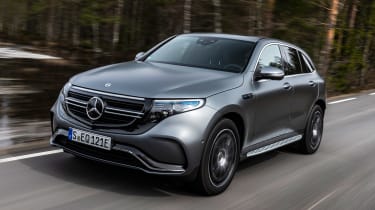
Due: NowPrice: £67,635Engine: 2x e-motor, 403bhp
The EQC is Merc’s e-tron rival. With an 80kWh battery and two electric motors giving 403bhp, it has a similar formula, and claims a 259 miles of range. It’s cheaper in AMG Line trim.
Figures
| Jaguar I-Pace EV400 AWD HSE | Audi e-tron 55 quattro | |
| On the road price/total as tested | £74,995/£85,234 | £72,270/£87,890 |
| Residual value (after 3yrs/36,000) | £52,646/70.2% | £49,866/69.0% |
| Depreciation | £22,349 | £22,404 |
| Annual tax liability std/higher rate | £2,398/£4,796 | £2,286/£4,572 |
| Annual electricity cost | £660 | £720 |
| Insurance group/quote/VED | 50/TBC/£0 | 50/TBC/£0 |
| Servicing costs | N/A | £799 (2yrs) |
| Length/wheelbase | 4,682/2,990mm | 4,901/2,928mm |
| Height/width | 1,565/2,011mm | 1,629/1,935mm |
| Engine | Dual-electric motor | Dual-electric motor |
| Peak power/revs | 395/N/A bhp/rpm | 402/N/A bhp/rpm |
| Peak torque/revs | 696/N/A Nm/rpm | 664/N/A Nm/rpm |
| Transmission | Single-spd auto/4wd | Single-spd auto/4wd |
| Battery capacity/spare wheel | 90kWh/Repair kit | 95 kWh/repair kit |
| Boot capacity (seats up/down) | 656/1,453 litres | 660/1,725 litres |
| Kerbweight/payload | 2,208/462kg | 2,490/640kg |
| Turning circle | 12.4 metres | 12.2 metres |
| Basic warranty (miles)/recovery | 3yrs (60,000)/3yrs | 3yrs (60,000)/3yrs |
| Driver Power manufacturer/dealer pos. | 9th/16th* | 16th/22nd* |
| NCAP: Adult/child/ped./assist/stars | 91/81/73/81/5 | 91/85/71/76/5 |
| 0-60/30-70mph | 4.4/3.7 secs | 5.4/4.3 secs |
| 30-50mph/50-70mph | 1.5/2.2 secs | 1.7/2.6 secs |
| Top speed/rpm at 70mph | 124mph/N/A | 124mph/N/A |
| Braking 70-0/60-0/30-0mph | 46.8/34.6/8.8m | 53.1/38.1/10.9m |
| Auto Express economy (miles/kWh) | 2.5 | 2.3 |
| Actual predicted range (miles) | 225 | 219 |
| Claimed range (WLTP combined) | 258 miles | 241 miles |
| Charging capability | 3.6/11/50/100kW | 3.6/11/50/150kW |
| Charging times (hours, minutes) | 27h/13h30m/71m/42m | 26h 45m/9h/70m/30m |
| Claimed CO2/tax bracket | 0g/km/16% | 0g/km/16% |
| Airbags/Isofix/park sensors/camera | Six/yes/yes/yes | Seven/yes/yes/yes |
| Auto box/lane-keep/blind spot/AEB | Yes/yes/yes/yes | Y/£1,950^/£625/y |
| Clim ctrl/cruise/leather/heated seats | Yes/adaptive/yes/yes | Yes/yes/yes/yes |
| Met paint/LED lights/keyless/pwr tail | £700/matrix/yes/yes | £750/yes/yes/yes |
| Nav/digital dash/DAB/connected serv | Yes/yes/yes/yes | Yes/yes/yes/yes |
| Wireless charge/CarPlay/Android Auto | No/yes/yes | Yes/yes/yes |
